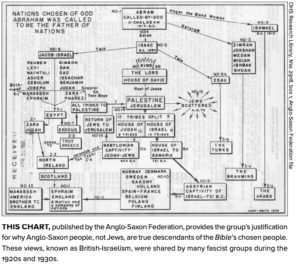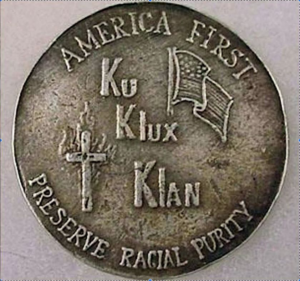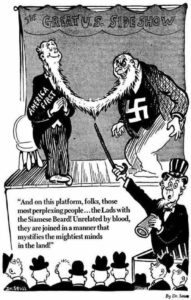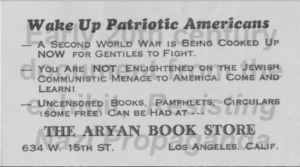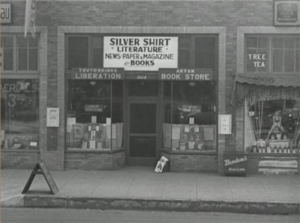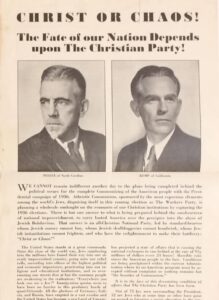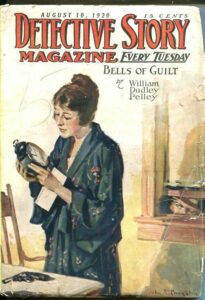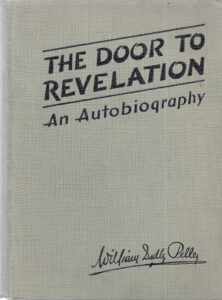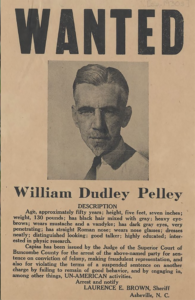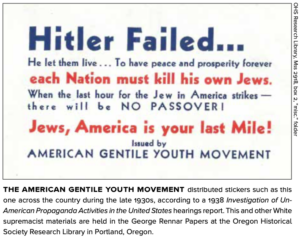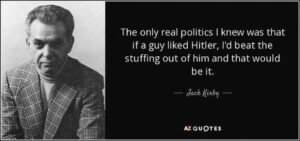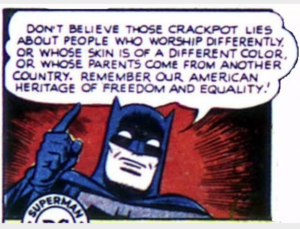MWA NorCal board member Dale Berry is a San Francisco-based writer and illustrator, who has produced independent comics since 1986. His graphic novels (the Tales of the Moonlight Cutter series, The Be-Bop Barbarians with author Gary Phillips) have been published by mainstream, as well as his own imprint, Myriad Publications, and his graphic short stories have appeared in Alfred Hitchcock’s Mystery Magazine. His life has included stints as a carnival barker, Pinkerton’s guard, professional stagehand, fencing instructor, and rock radio DJ. He and Gary Phillips wrote the chapter on Graphic Stories for MWA’s How to Write a Mystery.
(Credits: All images and samples are used for educational purposes only and constitute fair use. Dr. Seuss cartoons from the UC San Diego Digital Library collection. Batman is copyright DC Entertainment, Warner Bros. Global Brands and Franchises division of Warner Bros. Discovery and Warner Media, respectively. Jack Kirby is his own man. British-Israelism Genealogy chart, Gentile Youth sticker and much background information taken from: Burley, S. & Ross, A. R. (2019). “From Nativism to White Power: Mid-Twentieth-Century White Supremacist Movements in Oregon.” Oregon Historical Quarterly, 120(4), 564-587.)
Note: click on an image to see a larger version.
One could say it began as a reaction to the Industrial Age of the 19th and early 20th centuries, when there developed a newfound fascination with spiritualism and the supernatural World Beyond. Amidst a fresh embrace of fortune-tellers, seances, spirit-photography and general mysticism there were also renewed developments in charismatic and evangelical Christianity that featured faith-healing, the casting out of demonic forces, snake-handling, speaking in tongues, “dancing in the spirit,” “travail” (achieving emotional catharsis through the beating of pillows or inanimate objects) and other forms of ecstatic transport. Also, belief in a coming Armageddon.
These barnstorming fundamentalist religious groups, seeing themselves in opposition to older, more established (and wealthier) Christian orders, identified themselves with the poor and working classes and preached a more diverse, intimate, and personal relationship with the Creator. Over time, they’d also create diverse interpretations of Bible theology. As these evolved, some took very curious, and perhaps reductive directions. (In many ways, sadly following the similar behavior of those before them…in matters of slavery and intolerance, for instance.) One such splinter belief would help turn nativism into White Power, and by the mid-20th century, generate the spiritual core of America’s current militant nationalism.
So, what does this have to do with comic books, you ask? Well, after WWII, and with assistance from Big Business, the FBI, and the Republican Party, this group of believers would help drive crime comics off the market and censor the entire industry, as part of a return to “traditional Christian-American values.” Which sounds like a conspiracy theory but is actually quite true.
Stay with me. This will circle back.
British-Israelism, also known as Anglo-Israelism, became widespread throughout the British Empire and English-speaking world in the 19th century. Its roots originally lay in 16th century Protestantism, when French Huguenot magistrate M. le Loyer published The Ten Lost Tribes in 1590, presenting the idea that Anglo-Saxon, Celtic, Scandinavian, Germanic, and associated peoples were the true genetic descendants of the Old Testament Israelites.
Of course, the Catholic church had been excoriating Jews for multiple sins since the Middle Ages, and by official papal edict since the 16th century. The roots of antisemitism itself run even earlier. But now it was the anti-Catholic Loyer, through a (rather contorted) re-reading of Biblical text, who concluded that the Jewish people had originated because of rebellion against a divine commandment not to intermarry with “Edomites,” or were perhaps just genetically Khazar “Asiatics.”
It was a new rationalization for old resentments, and despite being disproven by all archaeological, ethnological, genetic, and linguistic evidence—in short, by the historical record itself—belief would now persist across Christian communities that the genetic bearers of the Divine Covenant, the Biblical “chosen people,” were actually Anglo-Saxon and not Jewish.
By the 17th century, multiple English treatises were advancing an “Israelite genealogy for the British people” as being the genuine descendants of the lost tribes of Israel. Bad scholarship and poor research aside, the idea grew in various Protestant religious circles throughout the 18th and 19th centuries, enfolding eschatology, plus numerology, pyramidology, Aryan Race Theory, and other pseudo-sciences as it went, until it bloomed as a distinct movement, formally organizing internationally across the British empire and commonwealth (the “Anglo-Israelism Association”), developing a sense of righteous Anglo-Saxon mission toward the world.
In 1886, its missionaries spread to the United States, where British-Israelism gospel took hold within rural Southern and mid-Western evangelical circles, appealing to a sense of white grievance and the “Lost Cause.” Membership in many of these regional fundamentalist churches often included overlapping membership with the Ku Klux Klan, where antisemitic bigotry became solidly fused with nativist racism by the late 19th and early 20th centuries, concurrent with a rise in American labor and industrial conflicts.
Jews soon became seen as helping generate the rise in Communism and secretly bankrolling the Russian revolution, despite their own centuries of oppression, exclusion and relocation (and, you know…pogroms). This all converged into the false notion of a wealthy “Jewish-Communist” global conspiracy that supported anti-segregationists, anti-industrialists, union organizers, socialists, and anarchists, and attempting to achieve a vague and frightening “One World Order.”
Southern Methodist J. Edgar Hoover, distrusting all of the above, but especially Communism since the Great Red Scare of 1919, began turning to what he considered informed, patriotic American corporate industrialists, primarily Republican, to help the FBI ferret out the country’s subversive elements. Although most major American industries were pro-fascist, doing business with fascist and authoritarian states overseas and embracing their notions of free enterprise and corporate rule above worker’s rights, this didn’t seem to bother Hoover so long as they were anti-union, anti-socialist, and, thus, anti-Communist.
By the Great Depression, influenced by the rise of fascism in Italy, Germany, and Spain, many antisemitic, Protestant-American fascist groups formed to vent their outrage towards perceived “overly-Jewish” influence on banking and the New Deal policies of Democrat president Franklin Roosevelt. Alongside distrust of papists, Freemasons, progressive liberal thought, and uppity peoples of color, Jews would now be paradoxically villainized as rich financiers, oppositional federal authorities, and Bolsheviks simultaneously.
These groups were often White Identity, authoritarian, and isolationist, distrustful of immigrants and dissidents. Some formed militias. Memberships intertwined, some groups fronting others. Notable pro-fascist and Nazi-associated organizations in the USA’s interwar years included the Friends of New Germany (later the German-American Bund), the American Liberty League, Christian America, the Black Legion, the American Defenders, Sentinels of the Republic, the Crusaders, the Silver Legion of America (later the Christian Party), and the plain old American Nazi Party.
William Dudley Pelley, by example, became a major figure in 1930s White supremacy movements. From a staunch Southern Methodist background (like Hoover), the political ideology and primary themes in Pelley’s many self-published magazines and newspapers consisted of anti-Communism, antisemitism, patriotism, corporatism, isolationism, and British-Israelism.
An award-winning author and former Hollywood screenwriter, self-styled religious mystic, a 1936 US presidential candidate and leader of the militarist Silver Legion of America (the “Silver Shirts,” peak membership: 15,000), he wrote that his followers should ready themselves “with a knowledge of Red-Jewish tactics,” so they could lead the country “when the aroused Christian element of the nation finally takes the form of vigorous vigilantism.”
During this same period came the formation of the National Association of Manufacturers, or NAM for short. Controlled and financed by 207 major companies, its purpose was to serve as a bridge between elite corporate owners and the working classes by developing and spreading “American business first” propaganda.
Sometimes this involved an ultra-conservative “news and opinion” radio show, with a daily listening audience of three million, hosted by a former NAM employee on the Mutual Broadcasting Network. Other times, it involved the American labor movement’s information being leaked to NAM members by a conniving J. Edgar Hoover. Still other times, NAM-affiliated US Chamber of Commerce and American Legion lobby groups influenced and contributed to a sympathetic, minority Republican Party. All extolled unregulated corporate “free market” capitalism with anti- “Communist unions” messaging that vowed to help America get back on its feet.
Patriotism and Big Business, fused with antisemitism, had gone mainstream across the USA. Prejudice wasn’t the reason overtly. It was also a convenient method for achieving autocratic goals.
In US congressional hearings of March 2, 1938, evidence was revealed that the 207 members of NAM were directed by a secret Special Conference Committee of 12 major corporations. Further, this committee was dedicated to the stated aim of destroying unions and promoting their own agenda, which included selling arms to Hitler and funding pro-fascist groups like the American Liberty League, the Black Legion and the Silver Shirts.
With its first president being Samuel Bush (father of Prescott, grandfather of George H.W. and great-grandfather of George W. Bush) and meeting in the offices of Standard Oil at 30 Rockefeller Plaza, these 12 leading firms were ATT, Bethlehem Steel, E.J. DuPont de Nemours, General Electric, General Motors, Goodyear Tire, International Harvester, Irving Trust, Standard Oil of New Jersey, U.S. Rubber, United Steel, and Westinghouse. Membership included names like Ford, du Pont, Rockefeller, Mellon (of Carnegie-Mellon), McCormick (of McCormick tractors and farm equipment) and Kress (of the national department store chain).
Pro-authoritarian corporate capitalists, using mass media populism and inside support from the FBI, combined with racist Christian Nationalist militias and minority-party Republicans.
I told you this would start to circle back.
Meanwhile, the hot, new, emerging comic book industry was just chock full of Jews.
Harry Donenfeld, a Romanian Jew from New York’s Lower East Side, owned and operated DC-National Allied Periodicals with his business partner Jack Liebowitz; also, the industry’s major distribution channel Independent News, plus stakes in several other publishing entities. DC publishing partner Max Gaines had first tested the idea of packaging and selling comic books on newsstands in 1933 (via shipping and delivery by the trucker’s union); Max’s division created and published such stalwarts as The Flash, Green Lantern, and the first successful female superheroine, Wonder Woman.
Superman’s creators Jerry Siegel and Joe Schuster, Batman co-creator Bob Kane (real name: Robert Kahn); rival Timely Comics publisher Martin Goodman, his editor and cousin-in-law Stan Lee (real name: Stanley Lieber), Captain America creators Joe Simon and Jack Kirby (real names: Hymie Simon and Jacob Kurtzburg); Will Eisner, his former “shop” partner Jerry Iger, and many, many others, too many to name, were all Jewish, whether observant or not.
Smart, imaginative, talented kids of immigrant families who had fled authoritarianism, war, and oppression overseas. The Jewish diaspora had pretty much created the American comic book industry, and its overall politics, like their artistic output, was wide-ranging and decidedly anti-fascist.
It was only a matter of time before these opposing elements would clash, spread out as they all were across the cultural landscape, jostling for attention in the nation’s spotlight.
When they finally did, it would be over the question of crime comics.
To Be Continued…

